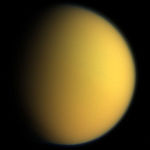Portal:Astronomy/Featured/April 2010

Titan (/ˈtaɪtən/, or as Ancient Greek: Τῑτάν), or Saturn VI, is the largest moon of Saturn, the only natural satellite known to have a dense atmosphere, and the only object other than Earth for which clear evidence of stable bodies of surface liquid has been found.
Titan is the sixth ellipsoidal moon from Saturn. Frequently described as a planet-like moon, Titan has a diameter roughly 50% larger than Earth's moon and is 80% more massive. It is the second-largest moon in the Solar System, after Jupiter's moon Ganymede, and it is larger by volume than the smallest planet, Mercury, although only half as massive. Titan was the first known moon of Saturn, discovered in 1655 by the Dutch astronomer Christiaan Huygens.
Titan is primarily composed of water ice and rocky material. Much as with Venus until the Space Age, the dense, opaque atmosphere prevented understanding of Titan's surface until new information accumulated with the arrival of the Cassini–Huygens mission in 2004, including the discovery of liquid hydrocarbon lakes in the satellite's polar regions. These are the only large, stable bodies of surface liquid known to exist anywhere other than Earth. The surface is geologically young; although mountains and several possible cryovolcanoes have been discovered, it is smooth and few impact craters have been discovered.
The atmosphere of Titan is largely composed of nitrogen, and its climate includes methane and ethane clouds. The climate—including wind and rain—creates surface features that are similar to those on Earth, such as sand dunes and shorelines, and, like Earth, is dominated by seasonal weather patterns. With its liquids (both surface and subsurface) and robust nitrogen atmosphere, Titan is viewed as analogous to the early Earth, although at a much lower temperature. The satellite has thus been cited as a possible host for microbial extraterrestrial life or, at least, as a prebiotic environment rich in complex organic chemistry. Researchers have suggested a possible underground liquid ocean might serve as a biotic environment.
Recently featured: GRB 970508 – Nebular hypothesis – Eris (dwarf planet)
| ...Archive | Read more... |
